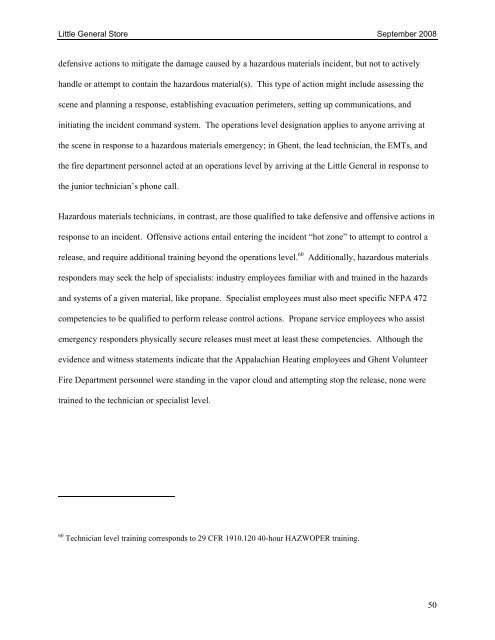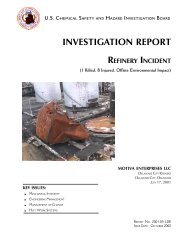Little General Store Propane Explosion - US Chemical Safety and ...
Little General Store Propane Explosion - US Chemical Safety and ...
Little General Store Propane Explosion - US Chemical Safety and ...
You also want an ePaper? Increase the reach of your titles
YUMPU automatically turns print PDFs into web optimized ePapers that Google loves.
<strong>Little</strong> <strong>General</strong> <strong>Store</strong> September 2008<br />
defensive actions to mitigate the damage caused by a hazardous materials incident, but not to actively<br />
h<strong>and</strong>le or attempt to contain the hazardous material(s). This type of action might include assessing the<br />
scene <strong>and</strong> planning a response, establishing evacuation perimeters, setting up communications, <strong>and</strong><br />
initiating the incident comm<strong>and</strong> system. The operations level designation applies to anyone arriving at<br />
the scene in response to a hazardous materials emergency; in Ghent, the lead technician, the EMTs, <strong>and</strong><br />
the fire department personnel acted at an operations level by arriving at the <strong>Little</strong> <strong>General</strong> in response to<br />
the junior technician’s phone call.<br />
Hazardous materials technicians, in contrast, are those qualified to take defensive <strong>and</strong> offensive actions in<br />
response to an incident. Offensive actions entail entering the incident “hot zone” to attempt to control a<br />
release, <strong>and</strong> require additional training beyond the operations level. 60 Additionally, hazardous materials<br />
responders may seek the help of specialists: industry employees familiar with <strong>and</strong> trained in the hazards<br />
<strong>and</strong> systems of a given material, like propane. Specialist employees must also meet specific NFPA 472<br />
competencies to be qualified to perform release control actions. <strong>Propane</strong> service employees who assist<br />
emergency responders physically secure releases must meet at least these competencies. Although the<br />
evidence <strong>and</strong> witness statements indicate that the Appalachian Heating employees <strong>and</strong> Ghent Volunteer<br />
Fire Department personnel were st<strong>and</strong>ing in the vapor cloud <strong>and</strong> attempting stop the release, none were<br />
trained to the technician or specialist level.<br />
60 Technician level training corresponds to 29 CFR 1910.120 40-hour HAZWOPER training.<br />
50









